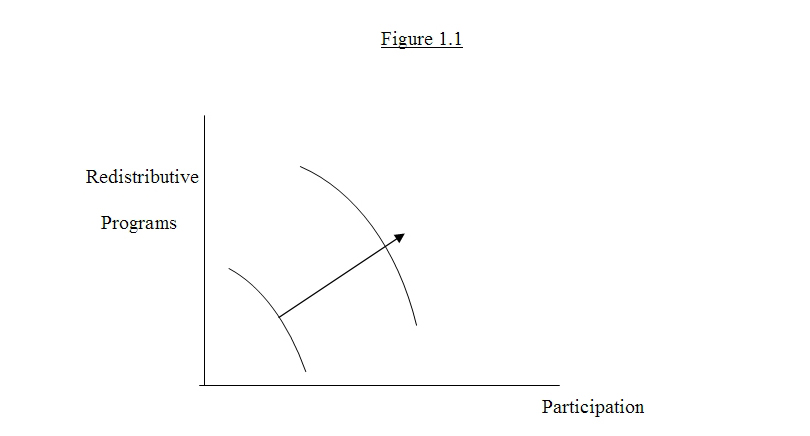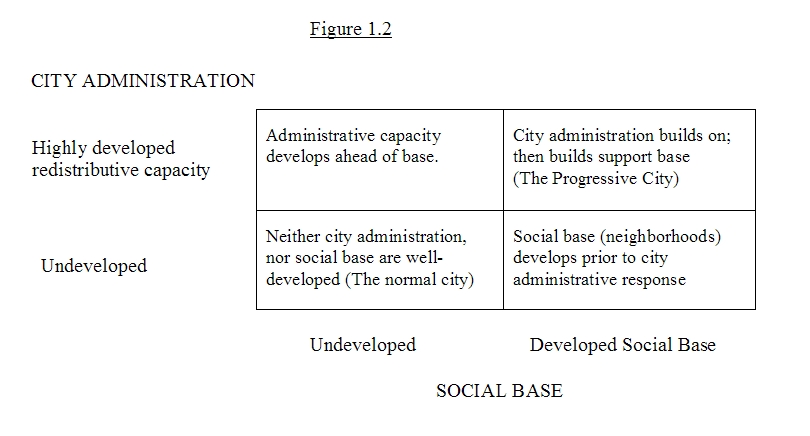Q2 – What is “progressive” in the Progressive City?
[Posted by Pierre Clavel — Adapted in part from Activists in City Hall (2010) and The Progressive City (1986) [i] ]What do we mean by “progressive?” Some have asked this, complaining that the term is vague and undefined. Maybe so, but here is a working definition: progressives worry about inequality and advocate steps to reduce it; and they try to open up government to wider citizen participation.
Progressives advocate redistribution. They would tax the rich and give to the poor. In Santa Monica in 1979, Santa Monica enacted rent control that redistributed millions from landlord profits to middle class pockets. In 1984 Boston enacted “linkage” rules that assessed downtown real estate to create an affordable housing trust fund, and Chicago enacted policies to retain manufacturing establishments that paid higher wages than the service establishments that might have replaced them. And Burlington, VT supported the Burlington Community Land Trust which, along with other measures, eventually resulted in protecting 17-20 percent of that city’s housing stock from price inflation.
Progressives also opened up city hall and government decision to public view and citizen participation. Berkeley and Santa Monica put city council meetings – previously hard to access – on the radio. Chicago adopted inclusionary city hall meeting practices – one official later said she would “never again be comfortable in meetings that did not include black, brown and female faces.” Boston and Burlington experimented with neighborhood councils. And many progressive city policies were not just openly arrived at within city hall; some originated in grass roots forums and organizations. Chicago’s industrial retention policy either originated in or received a critical push from a neighborhood forum that created the Chicago Workshop on Economic Development in 1982, resulting in a platform and collective sentiment that development should mean “Jobs, not real estate.” Boston’s linkage and neighborhood councils proposals received key support from propositions in a referendum in 1983, placed by the populist organization Massachusetts Fair Share.
Progressives were not purists – they wanted to establish their policies within governments, permanently if possible – and to that end were capable of compromise that got attacked from right and left. In Chicago, Harold Washington faced with demands from the White Sox baseball team for city support for a new stadium, concluded he had to comply even at the cost of damage to the surrounding neighborhood or be faced with electoral defeat. (His economic development commissioner, Robert Mier, later claimed some compensatory benefits from the city locking in luxury box revenues for neighborhood housing). In Boston Ray Flynn, a strong advocate of rent control to protect the city’s working and middle class population from escalating housing prices, finally settled for “linkage” – supporting downtown real estate developers’ plans even at the cost of pressure on housing prices in return for relatively modest contributions to an affordable housing trust fund. This arguably broke the back of business resistance to city interventions for affordable housing, but this result was n9ot obvious at the time and Flynn took criticism from both sides.
Experience was always uneven, but redistribution and participation can be seen as a “frontier,” conceptually. It is possible to diagram the way cities find their way toward neighborhood organizing, to progressive administration, or both. I did this in The Progressive City — an earlier work based on research in five smaller cities and from the standpoint of electoral coalitions and leadership that had captured control of council majorities or mayoralties: Hartford. Cleveland, Santa Monica, Berkeley, and Burlington. I defined a “progressive city” as the intersect of two dimensions, redistributive and participatory reforms initiated by the city government. For those places, one could see a progression traceable across the diagram. These “progressive city” cases seemed to exist toward the outer frontier in the diagram compared to the “normal city”, which was closer to the origin. However they also varied along the curve. Some of these cities seemed to have more success with a series of administrative reforms carried out against a background of civic ferment, but not necessarily involving a well developed pattern of neighborhood participation. This could be a problem, as they stalled with significant redistributive efforts not balanced by participation: Dennis Kucinich in Cleveland, and Nicholas Carbone in Hartford were each defeated in part due to the opposition or apathy of the neighborhood organizations in 1979. Others started in a more participatory manner. Perhaps these deviated further from the “normal” on both dimensions, eventually. Burlington was the clearest example, but there were significant efforts in Berkeley and Santa Monica as well.
The text above is written as if “progressive cities” are a city hall thing: mayors initiate redistributive programs, and city hall allows participation. A more nuanced conception of “the progressive city” would include the observation that all or most of the innovations characterizing these places had roots in a social movement that found a common cause in neighborhood issues. This shifts the focus. Not only was there a dual problem from the standpoint of the progressive city administrator and political leadership; but there were also two standpoints from which to see the history of these cities: that of the city government on the one hand, and that of the movement and its successor institutions outside of the city government.
Conceptually, the revised approach is only partly different from the earlier one. Redistribution and participation remain the salient dimensions of variation among cities. But the institutions – and our view of them — become more deeply layered. Instead of the city government being the main focus, we now look at the government along with the neighborhood organizations that support or oppose it. Instead of “redistribution” we might expand that dimension to include “administratively developed” to recognize that success in redistributive policy is partly a matter of having the administrative wherewithal to implement a redistributive concept. Instead of the government-focused term, “participation,” we will signify the less fragile institutions represented by CDCs and the like, by referring to a developed versus undeveloped “social base.” The new diagram, converted to a set of boxes, would look as follows:
This diagram suggests a starting point for a review of the succeeding chapters. As in the earlier diagram, the “normal city” is toward the lower left while the “progressive city” is to the upper right. In the course of time it would seem that a city could move through the boxes. But how did cities move toward the progressive corner?
A first set of observations would refer to the engine of change: what is the social base for movement along either dimension? Or rather, what did the progressive city activist think was the social base? [ii] Next, how did places move – i.e. from one part of the diagram to another? If there was a movement base, how did either sort of institution – neighborhood group or city administration — develop, what were the trajectories, taken separately?
Then there is the question of the relationship between the two dimensions. Here the story becomes harder to disentangle, and many things are only partly known at best. In part, the problem is that the development is uneven and incomplete. Few of the “progressive” city governments in the United States were still in power at the end of the 1990s, though they remained a powerful metaphor for future developments and might yet return to prominence in some cyclical fashion. For example, elements of the Washington and Flynn programs continued under their successors, Richard M.Daley and Thomas Menino in Chicago and Boston. Progressive governments remained in control in Berkeley and Santa Monica, though their programs had moderated; and something similar happened in Santa Cruz and Madison. In Burlington, the Progressive Coalition had developed further. Hartford and Cleveland, having defeated its radical leadership in 1979, witnessed revivals in lesser respects. Even in Cleveland, where progressive government ended dramatically with Kucinich’s defeat in 1979, there was a comeback over a twenty year period as neighborhood based housing organizations strengthened and city hall operated more as a complement to coordinated neighborhood leadership. In that sense Cleveland was now more thoroughly a progressive city. [iii]
[i] Clavel, Pierre. The Progressive City: Planning and Participation, 1969-1984. (New Brunswick, NJ: Rutgers University Press, 1986); and Activists in City Hall: The Progressive Response to the Reagan Era in Boston and Chicago. (Ithaca, NY: Cornell University Press, 2010).
[ii] I am using the idea of the “social base” in the sense meant by Philip Selznick, meaning the external clienteles and support groups that can be mobilized to affect the internal dynamics of an organization or public agency. See Selznick, Philip, Leadership in Administration (Berkeley: University of California Press, 1957).
[iii] Yin, Jordan.. “The Community Development Industry System: A Case Study Of Politics And Institutions in Cleveland.” Journal of Urban Affairs 20 (Summer 1998): 137-157.


